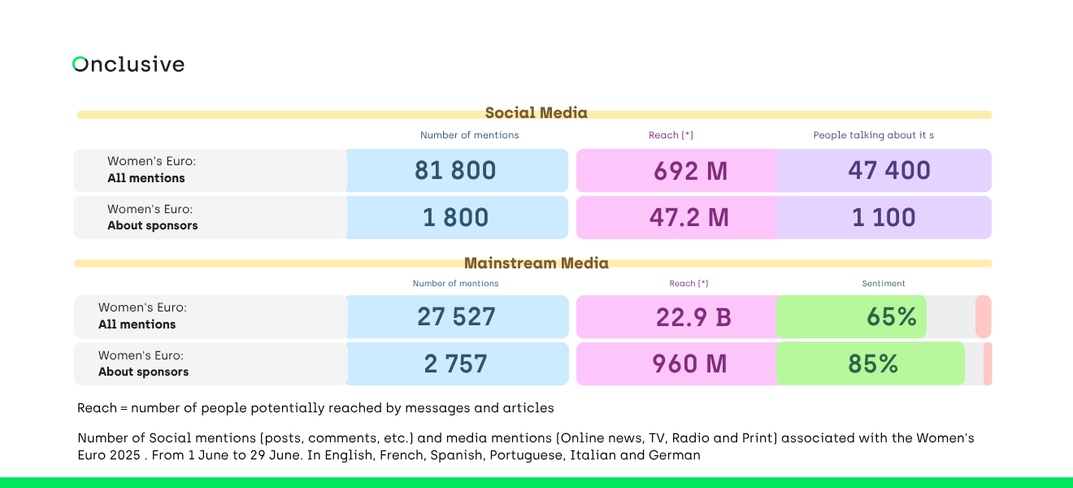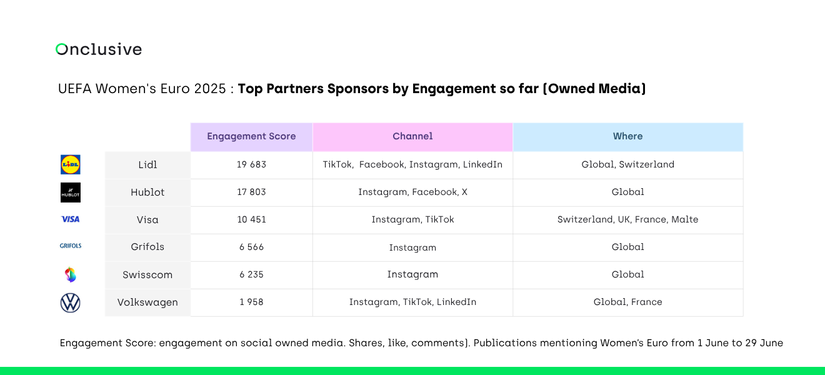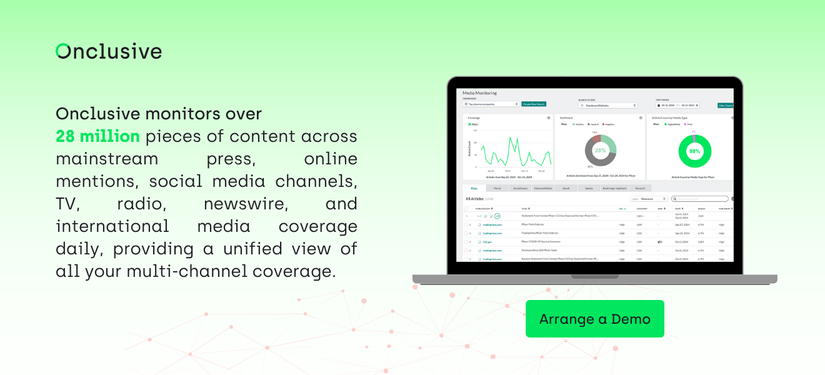The numbers coming out of Switzerland are staggering. UEFA Women’s Euro 2025 sponsorship revenue is projected to reach €32.5 million—a 112% increase from 2022—while sponsors are already generating 47.2 million in reach with an impressive 85% positive sentiment score.

But here’s what’s really interesting: while most sponsors stick to tired playbooks of ticket giveaways and basic activations, smart brands are building something bigger. With 76% of European sports fans now watching women’s football live on TV (up from 53% in 2022) and 20-21 global sponsors confirmed, the brands succeeding understand that sustainable Women’s Euro 2025 sponsorship strategy extends far beyond tournament dates.
Here are the seven strategies driving this remarkable commercial success:
1. AXA’s Year-Round Advocacy Blueprint
The Strategy: AXA isn’t just sponsoring Women’s Euro 2025—they’re building authentic advocacy that extends throughout the year.
Rather than limiting their women’s football messaging to the July 2-27 tournament window, AXA has launched campaigns positioning the Euro as part of a broader commitment to women’s sports. Their “Keep on Kicking” campaign extends beyond traditional football to include Walking Football, demonstrating support for women’s participation in sport at all levels.
Why It Works: AXA connects women’s football to their broader brand messaging around gender equity. By linking sports sponsorship to themes like the gender health gap with messaging like “Being a woman shouldn’t be a risk,” they’ve created authentic narrative threads that resonate year-round. Our data shows this storytelling approach generating significantly higher engagement than standard tournament activations.
Key Takeaway: Brands that connect tournament sponsorship to their core values and extend messaging beyond event dates see measurably better results.

2. Lidl’s Community-First Innovation
The Strategy: Lidl transformed traditional tournament marketing into community-driven storytelling through their “Never Stop Growing” initiative.
Instead of standard Euro 2025 marketing, Lidl created anticipation through a series visiting Swiss cities hosting football matches. This localized approach has succeeded in building audience loyalty through frequent, authentic content on TikTok—proving that creativity trumps budget when it comes to engagement.
The Results: Our monitoring shows Lidl leading all sponsors with an engagement score of 19,683, primarily through TikTok, Facebook, Instagram, and LinkedIn in Switzerland. Their success demonstrates how localized, authentic content can outperform broader traditional campaigns.
Why It Resonates: By focusing on Swiss communities rather than generic tournament messaging, Lidl built genuine connections with the host nation while creating content that feels authentic rather than advertising-heavy.
Key Takeaway: Community-focused strategies that tell local stories often generate higher engagement than broad, generic tournament campaigns.

3. Volkswagen’s Corporate Integration Strategy
The Strategy: Volkswagen treats women’s football as core business messaging rather than a marketing add-on.
Instead of isolating their women’s Euro sponsorship within their sports marketing division, Volkswagen promotes women in football through their corporate communications. This integration signals a fundamental shift from tournament sponsorship to authentic brand positioning around gender equity in sports.
The Impact: This approach allows Volkswagen to maintain consistent messaging about supporting women in sports throughout the year, not just during major tournaments. It positions them as genuinely committed to gender equity rather than opportunistically capitalizing on trending topics.
Key Takeaway: Brands that integrate women’s sports messaging into their core corporate communications rather than treating it as separate campaigns build more authentic brand positioning.
4. Adidas’s Product Innovation + Gaming Combo
The Strategy: Adidas uses tournament timing to launch broader initiatives that extend well beyond July 2025.
Coinciding with Women’s Euro 2025, Adidas is introducing their first model of shoes specifically designed for women—the F50 Sparkfusion—while simultaneously launching a new version of their UEFA Women’s EURO mini game on Roblox. Portuguese team players are actively promoting the shoes on their Instagram accounts, creating authentic endorsement that extends beyond paid partnerships.
The Genius: This strategy combines product innovation, digital gaming, and authentic athlete partnerships into a cohesive campaign that will continue generating value long after the tournament ends.
The Results: By connecting tangible product launches to tournament timing, Adidas creates lasting business value rather than temporary marketing buzz.
Key Takeaway: Smart sponsors use tournament windows to launch initiatives that create ongoing business value rather than just short-term awareness.
5. The Platform Strategy: Instagram + TikTok Mastery
The Strategy: Leading sponsors understand that each platform requires different approaches while maintaining consistent authentic messaging.
Our data confirms that Instagram remains the preferred social network for partner brands to communicate, but TikTok is close behind. This platform mix offers sponsors multiple ways to reach audiences, from Instagram’s polished brand messaging to TikTok’s authentic, community-driven content.
What Works: Brands like Lidl that have mastered TikTok engagement are seeing remarkable results because they adapt their content strategy to each platform’s unique culture rather than posting identical content everywhere.
The Data: Sponsors generating the highest engagement scores are those using Instagram for polished brand storytelling and TikTok for authentic, community-focused content that feels native to each platform.
Key Takeaway: Successful Women’s Euro 2025 sponsorship strategy requires platform-specific content approaches, not one-size-fits-all messaging.

6. Player Partnership Content That Actually Works
The Strategy: The most successful sponsors focus on collaborative content creation with actual
players rather than traditional celebrity endorsements.
Our monitoring reveals the most important insight: content that partners with, interviews, or involves actual players from women’s national teams generates the highest engagement per post. This isn’t just about celebrity endorsement—it’s about authentic connection to the sport itself.
Examples That Work: Quizzes from VW France and AXA, interviews with Visa and Swisscom, and behind-the-scenes content consistently outperform standard advertising approaches.
Why It’s Effective: Audiences respond more positively to collaborative content that showcases players as partners rather than simply paid endorsers. This approach builds authentic connections between brands, athletes, and fans.
Key Takeaway: Collaborative content creation with players generates higher engagement than traditional celebrity endorsement or advertising-heavy approaches.
7. Beyond Tournament Thinking: The Long Game
The Strategy: The most successful sponsors recognize women’s sports as a strategic marketing platform rather than a tactical tournament opportunity.
While traditional sponsors invest heavily for 25 days then disappear, strategic brands understand that Women’s Euro 2025 serves as a template for year-round women’s sports marketing. With the Women’s World Cup scheduled for 2027 and continued growth across women’s professional leagues, brands establishing authentic positioning now gain significant advantages.
The Business Case: Sponsorship deals in women’s sports are increasing 12% year-over-year compared to 8% growth in men’s sports—nearly 50% faster growth in a market projected to reach $1.3 billion.
The Sentiment Advantage: Our data shows sponsor-related content about Women’s Euro 2025 achieving 85% positive sentiment compared to 65% for general tournament mentions. Audiences reward authentic commitment over opportunistic tournament marketing.
Key Takeaway: Brands that understand women’s sports as a long-term strategic platform rather than short-term tactical opportunity position themselves for sustained success in a rapidly growing market.
The Data Behind the Success
Early Momentum Numbers:
- 81,800 social media mentions generating 692 million in reach
- 47,400 people actively talking about sponsors before tournament begins
- Switzerland leading conversation (22.9% of mentions), followed by England (19.7%), Spain (13.2%) and France (10.2%)
tbdf
Platform Insights:
- Instagram preferred for polished brand messaging
- TikTok rising for authentic community content
- Brands adapting content strategy to each platform seeing highest engagement
Geographic Strategy:
- Local focus (like Lidl in Switzerland) often outperforms broad global messaging
- Targeted regional approaches (Visa in Switzerland, UK, France, Malta) showing strong results
Key Takeaways for Marketing and Comms Pros
The revenue doubling from €15.3 million in 2022 to €32.5 million in 2025 isn’t just about tournament growth—it’s about brands finally understanding how to approach women’s sports marketing strategically.
The winners share common approaches:
- Year-round advocacy rather than tournament-only presence
- Authentic storytelling connected to brand values
- Platform-specific content strategies
- Collaborative partnerships with players
- Community-focused rather than generic messaging
- Integration with core business rather than isolated campaigns
- Long-term strategic thinking about women’s sports growth
The Bottom Line: As over 550,000 tickets sell and audiences respond with 85% positive sentiment to sponsor content, the message is clear. The brands building authentic, year-round advocacy around women’s football are capturing disproportionate value in one of sports marketing’s fastest-growing segments.
The tournament begins July 2nd, but the real game started long before—and the smartest sponsors know it won’t end when the final whistle blows in Switzerland.
